With US major equity indices near all time high, investors concluded 2016 with great optimism. A new era is dawning with Trump's US presidential election victory in November.
The US Dollar Index broke through the psychological 100 level, reaching a decade high as investors chased rising yields and subscribed to the prospect of an improving US economy (“Make America great again!”)

The Dow Jones Industrial Average index reached a new all-time high as equities investors anticipate higher consumer spending and corporate earnings, lower tax rates across the board, repatriation of foreign earnings, mega-fiscal infrastructure spending, and steadfast de-regulation.

President-elect Trump is a great salesman – he had a pitch for everyone. Such euphoria reminded me much of 1999, where all tides were rising in the face of rising interest rates.
As we enter into 2017, which “mole” is likely to get “whacked”? Let's visit:
Interest Rates
Bond yields for all maturities jumped substantially since the November US Presidential election.
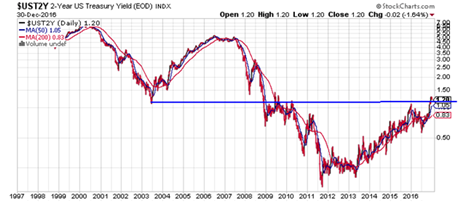
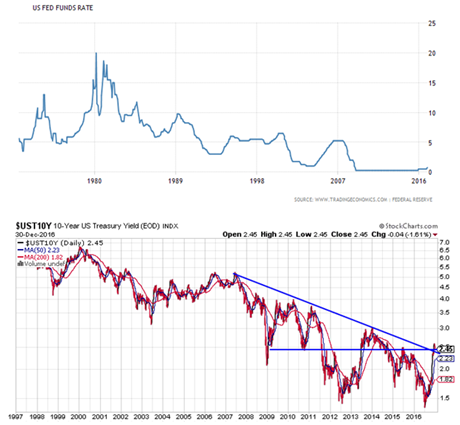

The main-stream press put a positive spin on rising yields as the sign of imminent economic expansion. To me, it comes down to supply and demand: yields need to rise if more government borrowing is in store to fund the railways, bridges, airports and wall at the US-Mexican border.
Looking at the long term trend, yields remain firmly in a downtrend since 2000 (or since 1980, if you wish the draw the line that far) suggesting inflation and/or growth remain tepid.
Keep in mind though, that yields have always been tough to forecast and explain because they are highly distorted by the federal and foreign governments (where profit-seeking is not the sole objective in holding treasury paper), which collectively own more than 50% of US treasury securities.
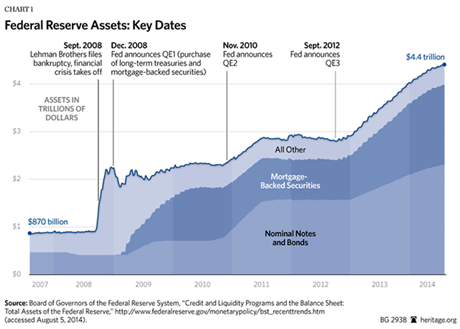
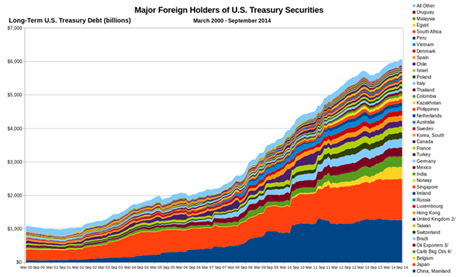
The 2-year treasury yield bottomed in 2013 and has been rising ever since.
My gut tells me more Federal Reserve rate hikes are in store because of rising treasury yields. The market can possibly cushion a maximum of an additional 50 basis point increase in yields, with the Federal Reserve guarding closely and ready to reverse rate hikes at any sign of distress (such as slower GDP, rising unemployment, fall in consumer spending, low consumer sentiment, or rising mortgage defaults) – and don't be surprised if the Federal Reserve deploys Quantitative Easing in an attempt to rein-in 2-year and 10-year yields.
Keep in mind, with government debt to GDP at about 100%, a 1% hike in interest rates would mean a 1% drag on GDP.
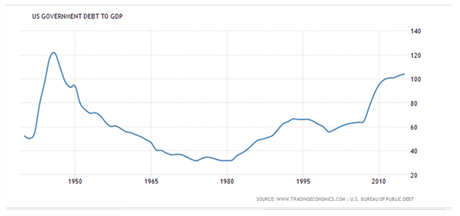 US Equities and Economy
US Equities and Economy
The Dow, S&P 500 and NASDAQ have all posted all-time highs since November, registering 8%, 5% and 3% gains since November 1, respectively. Much of these gains were driven by the financial and transportation sectors.
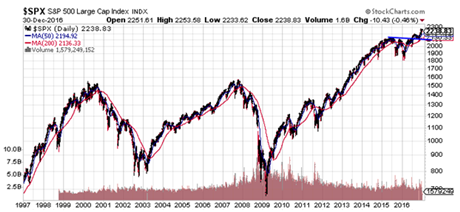
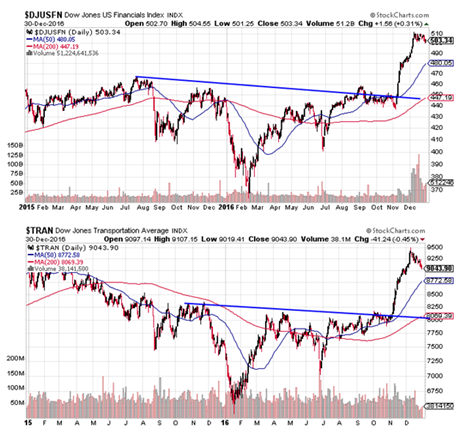
Dividend stocks with heavy debt like in the utilities sector have been flat however. So is the home construction sector which is in fact, rolling over. Both indices are beneath their 200-day moving-average and flashing warning signs with further rising yields. While Bankers rejoice today as yields climb back from unnatural negative territory, the festivity may be short-lived if long-term rates continue to climb, and the lending business begins to slow and mortgage portfolios start to turn sour.
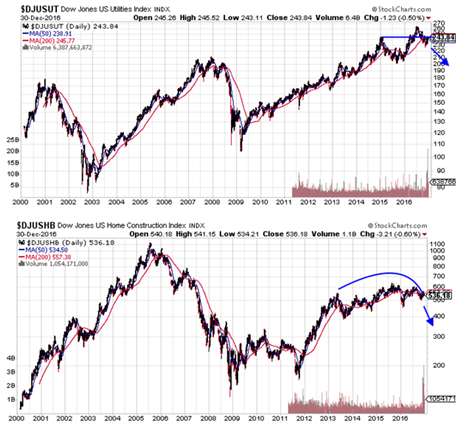
Everyone asks the same question: Just how much of the future growth has been factored in by the market? Without expanding this subject into a book, I will bring up manufacturing growth, infrastructure spending, and offshore repatriation tax revenue as stimulus examples.
Revival of the US manufacturing sector has been a hot topic. Currently, the value added by the manufacturing sector is approximately 12% of the US GDP, or about US$2 trillion (i.e. US$17 trillion x 12%). A 5% growth in manufacturing (i.e. US$100 billion) through Trump's policies to bring jobs back from Mexico and China would translate to a 0.6% growth in GDP. The numbers seem reasonable within Trump's first term, considering the examples set by advanced manufacturing powerhouses Germany and Japan, where their manufacturing sectors account for 23% and 19% of their country's GDP, respectively.
[1]
If Trump wants to bump US GDP growth from 2% to 3%, where will the rest of this growth come from?
According to a Bloomberg article dated November 13, 2016:
"President-elect Donald Trump has proposed spending up to $1 trillion over a decade to make America's infrastructure ‘second to none.’
Except for China that is.
The world's second-largest economy has already topped that this year alone, with $1.4 trillion splurged on roads, railways, bridges, telecom networks and other infrastructure in the ten months through October.
Trump's plan for an "America's Infrastructure First" policy mirrors China's build-it-and-they-will-come model, except on a much smaller scale. China has spent about $11 trillion on infrastructure in the last decade -- more than 10 times what Trump is proposing. Some economists reckon it needs to spend about $2 trillion a year going forward to keep economic growth humming at today's level.
That building binge has transformed China's continent-sized economy. Its 20,000 kilometers of high-speed railways account for more than 60 percent of the world's total, and it's not done yet, with plans to boost that distance to 30,000 kilometers by 2020."
[2]
“Acela Express trains are the only true high-speed trainsets in the United States. Amtrak uses them on a high-speed service between Washington, D.C. and Boston via New York City and Philadelphia along the Northeast Corridor (NEC) in the Northeast United States.”
[3]
US$68 billion is reportedly the cost for the 520-mile high-speed rail linking San Francisco to Los Angeles.
[4]
0.6% of US GDP is US$100 billion – a very reasonable infrastructure spending amount to add to GDP growth. This spending can be funded by the 10% repatriation tax levied from overseas profits estimated at US$2.9 trillion in cash by Nomura.
[5]
If this one-time tax revenue source doesn't pan out, Trump can resort to deficit spending. Current deficit numbers aren't as dire as most conservative hawks portray :
The US budget deficit in 2016 was approximately US$600 billion, or about 3% of the US GDP. An extra US$100 billion allocation to infrastructure would increase the ratio of deficit to GDP by 0.5% to 3.5%, which would still be below the historic average since 1970.
[6]
[6] “Federal Deficit Analysis.”
usgovernmentspending.com. Christopher Chantrill, 4 Jan. 2017.
https://www.usgovernmentspending.com/federal_deficit_percent_gdp
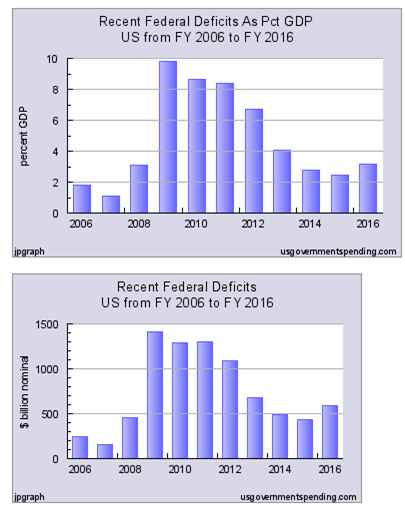

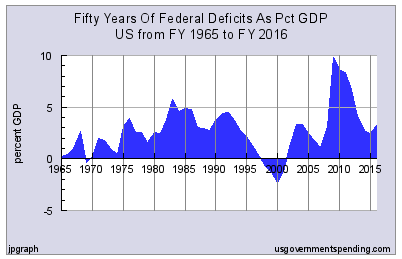
The
caveat to this entire rosy outlook, is that the housing market and consumer spending must hold up.
Given the close correlation between 2-year treasury yields and the federal funds rate, if the 2-year yield continues to trend up (for whatever reason: capital flight from China, rising inflation, other foreign government staged trade war with the US by selling of US treasury securities, or a larger-than-life fiscal deficit, to name a few), the Federal Reserve will be forced to hike rates aggressively in 2017, which could prematurely choke off any future growth to come.
By the same token, if long-term yields continue to rise unabated, it would make a serious dent in the US$13 trillion mortgage market, damaging both consumer spending (which accounts for 2/3 of the US economy) and the stability of the financial sector that holds non-performing mortgage portfolios facing a big valuation haircut.
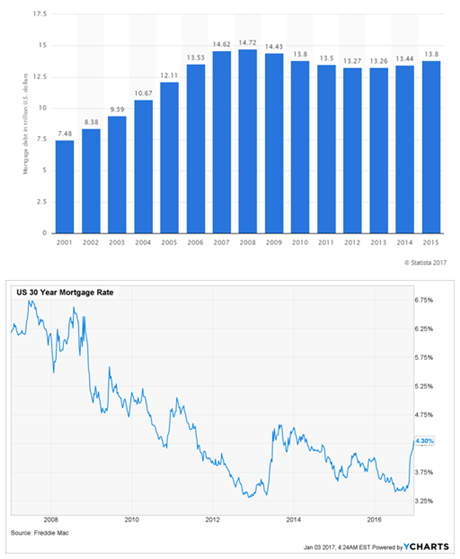 Copper and Oil
Copper and Oil
Copper and oil prices are up in anticipation of greater raw materials consumption through building railroads, airports, and the wall at the US-Mexican border) While the rally is impressive in the face of a stronger US dollar as investors are bidding up copper based on a promise and not present day reality Will the rally be sustainable throughput 2017 or will it turn into buy on rumor, sell on news variety?
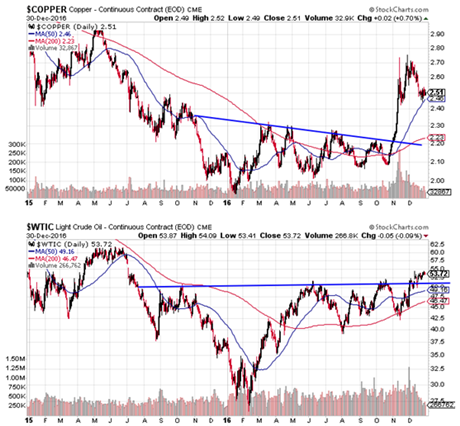
In summary, the technical upside break-out of the US dollar index and equity markets must be respected until the trend reverses.
Trump’s team can plausibly achieve 3%-4% GDP growth with deficit spending. In absolute terms, a 1% hike in US GDP = US$170 billion, and a 5% recent hike in the US equity market translates to approximately a US$1.1 trillion increase. Only time will tell if the additional 1% Trump induced GDP is enough to satisfy US dollar and equity investors at current valuations.
Weakness can already be seen in the utilities and housing sectors. If consumer spending slows due to rising yields or if Trump is unable to push through ambitious fiscal policies, we could see a quick reversal and downward spiral in yield, equities, copper, and the US dollar.
Instead of shorting the surging US dollar, I am averaging in gold and silver purchases, which are contrarian plays to the US dollar.

Adventurous investors can consider investing in gold and silver mining companies. One such company is Prophecy Development Corp. (TSE: PCY, OTCPK: PRPCF).
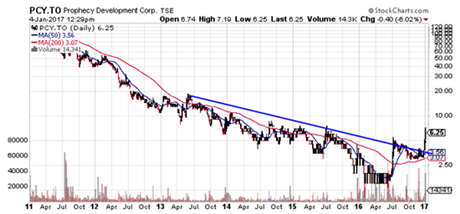
As we enter into the Chinese zodiac year of the fire rooster (which, of The Five Elements, belongs to Metal (Jin – or “gold”)), perhaps it's a sign of good times to come in 2017 for the gold bull?
[1]
I own physical silver and manage Prophecy Development Corp. (TSX: PCY, OTCPK: PRPCF) which engages in silver exploration.
John Lee, CFA.
jlee@prophecydev.com
[1] “Rooster (zodiac).” Wikipedia, The Free Encyclopedia., 1 Jan. 2017.
https://en.wikipedia.org/wiki/Rooster_(zodiac)
 John Lee, CFA
John Lee, CFA is an accredited investor with over 2 decades of investing experience in metals and mining equities. Mr. Lee joined Prophecy Development Corp. (
www.prophecydev.com) in 2009 as the Company’s Chairman. Under John Lee’s leadership, Prophecy raised over $100 million through the Toronto Stock Exchange and acquired a portfolio of silver assets in Bolivia, coal assets in Mongolia, and a Titanium project in Canada. John Lee is a Rice University graduate with degrees in economics and engineering.